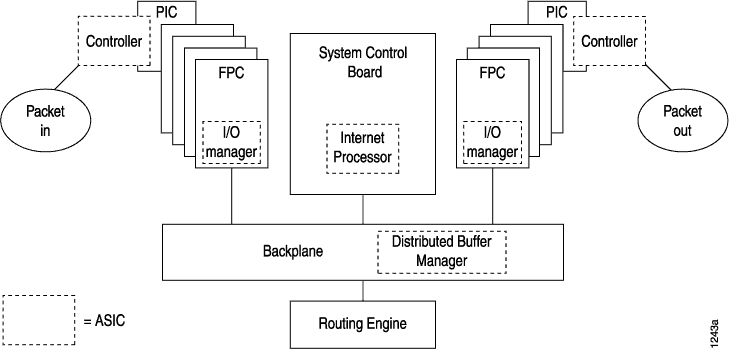Packet Flow on Juniper Networks M Series Multiservice Edge Routers
On M Series Multiservice Edge Routers, CoS actions are performed in several locations in a Juniper Networks router: the incoming I/O Manager ASIC, the Internet Processor II ASIC, and the outgoing I/O Manager ASIC. These locations are shown in Figure 1.

This topic describes the packet flow through the following components in more detail:
Incoming I/O Manager ASIC
When a data packet is passed from the receiving interface to its connected FPC, it is received by the I/O Manager ASIC on that specific FPC. During the processing of the packet by this ASIC, the information in the packet’s header is examined by a behavior aggregate (BA) classifier. This classification action associates the packet with a particular forwarding class. In addition, the value of the packet’s loss priority bit is set by this classifier. Both the forwarding class and loss priority information are placed into the notification cell, which is then transmitted to the Internet Processor II ASIC.
Internet Processor ASIC
The Internet Processor II ASIC receives notification cells representing inbound data packets and performs route lookups in the forwarding table. This lookup determines the outgoing interface on the router and the next-hop IP address for the data packet. While the packet is being processed by the Internet Processor II ASIC, it might also be evaluated by a firewall filter, which is configured on either the incoming or outgoing interface. This filter can perform the functions of a multifield classifier by matching on multiple elements within the packet and overwriting the forwarding class, loss priority settings, or both within the notification cell. Once the route lookup and filter evaluations are complete, the notification cell, now called the result cell, is passed to the I/O Manager ASIC on the FPC associated with the outgoing interface.
Outgoing I/O Manager ASIC
When the result cell is received by the I/O Manager ASIC, it is placed into a queue to await transmission on the physical media. The specific queue used by the ASIC is determined by the forwarding class associated with the data packet. The configuration of the queue itself helps determine the service the packet receives while in this queued state. This functionality guarantees that certain packets are serviced and transmitted before other packets. In addition, the queue settings and the packet’s loss priority setting determine which packets might be dropped from the network during periods of congestion.
In addition to queuing the packet, the outgoing I/O Manager ASIC is responsible for ensuring that CoS bits in the packet’s header are correctly set before it is transmitted. This rewrite function helps the next downstream router perform its CoS function in the network.
Enhanced CFEB and CoS on M7i and M10i Routers
The Enhanced Compact Forwarding Engine Board (CFEB-E) for the M7i and M10i Multiservice Edge Routers provides additional hardware performance, scaling, and functions, as well as enhanced CoS software capabilities.
The enhanced CoS functions available with the CFEB-E on M7i and M10i routers include:
Support for 16 forwarding classes and 8 queues
Support for four loss priorities (medium-high and medium-low in addition to high and low)
Support for hierarchical policing with tricolor marking, both single-rate tricolor marking (TCM) and two-rate TCM (trTCM)
